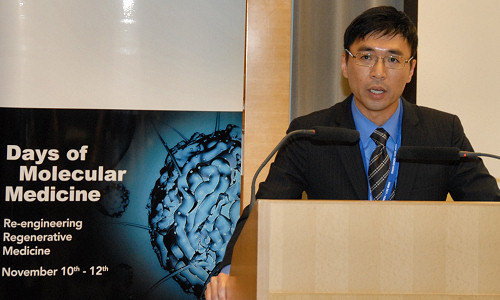UC Davis researchers have successfully used a custom designed protein and gene delivery system to restore normal heart rhythms in pigs with electronic pacemakers, reducing their dependence on implanted devices. This work suggests that scientists are one step closer to making bioengineering a reality in treating the more than 2.2 million Americans affected by irregular heartbeats.
The UC Davis study, which was co-authored by an international team that included scientists from the University of Hong Kong and Johns Hopkins University, is published in the current issue of the journal Circulation, (which is available online and will appear in print on September 5). The same issue also includes a similar but independent research effort by scientists from Columbia University and State University of New York at Stony Brook.
“Our study offers positive and direct evidence in living models that bioengineered cells can replace the electronic pacemaker,” said Ronald Li, who leads the research team and is an associate professor of cell biology and human anatomy at the UC Davis School of Medicine. More than 250,000 people in the United States get artificial pacemakers implanted each year. Researchers believe this biological approach would provide a more permanent, reliable and less invasive alternative to implanted electronic devices. “Our hope is to one day replace electronic pacemakers in people,” Li said.
Li and his colleagues have been working for years to develop biological alternatives to drugs and electronic devices for treating heart arrhythmias — heartbeats that are irregular in rhythm, rate or sequence. The sinoatrial (SA) node, a patch of cells called the pacemaker, generates cardiac rhythms for coordinated contractions and blood pumping. Malfunctions due to aging or diseases can lead to a range of potentially lethal arrhythmias, such as slow heart rates or rhythms called bradycardias.
In the current study, the researchers delivered a gene encoding a bioengineered cell-surface protein to heart muscle cells of pigs. This protein mimics the combined action of several proteins called HCN ion channels, which play a critical role in maintaining a normal, evenly paced heartbeat. These channels control the flow of sodium and potassium ions in and out of cells that regulate the electrical impulses of the heart.
“These channels are critical to normal heart function. We were able to make one protein that codes for a single channel that does the work normally required by several,” Li explained.
By getting heart muscle cells to produce bioengineered HCN channels, Li and his colleagues were able to reconstruct the SA node of the heart in pigs with implanted electronic pacemakers. The SA node is normally located on the right atrium, the upper right chamber of the heart that receives deoxygenated blood from the body.
“We were even able to create new pacemaker regions on the left atrium,” Li said.
According to Li, the current study moves research beyond using animal models such as mice and rats, whose hearts can beat up to 600 times per minute. Large animals such as pigs make for far more realistic models because their anatomy and physiology, including average heart rates of about 70 to 80 beats per minute, are similar to humans.
In the current study, researchers used radiofrequency ablation to remove the SA nodes in pigs’ hearts. This is the same minimally invasive technique cardiologists use in clinics to destroy the heart cells that cause abnormal electrical discharges and rapid heart rates in their patients. To restore the SA node function and evaluate the bioengineered cells, Li’s team then implanted electronic cardiac pacemakers like those used in humans and injected an adenovirus carrying a gene encoding for the engineered HCN protein into the heart muscle. Adenovirus has the ability to deliver its own genes into a host cell and hijack its protein-synthesizing machinery. Scientists use this ability to deliver genes of interest into cells.
In a matter of days following the gene transfer, the pigs’ hearts had generated bioartificial nodes at the injection sites. Li explained that, through gene expression, normal muscle cells of the heart were converted into pacemaker cells by a process called transdifferentiation. Studies done two weeks after the injections showed the new nodes were able to take over pacemaking function from the electronic devices. The results also have implications for future stem cell research.
Li and his colleagues are now preparing to do long-term, follow-up experiments. UC Davis offers a unique environment for this work to be continued through eventual testing in humans, Li said.
“It is a place where we can do the basic laboratory science, test in animal models, utilize the only non-human primate facility in California and eventually partner with physicians at the UC Davis Health System to treat patients,” he said.
Li and his team previously generated the first bioengineered human heart cells from human embryonic stem cells, and demonstrated that they can be transplanted into a recipient heart and function normally. Li plans to combine stem cells and protein/cell engineering approaches to the treatment of heart arrhythmias.
“Heart cells do not normally regenerate, but we now have the technologies to make new human heart cells using stem cells. And, we can also customize these cells to treat diseases,” he said.
Co-authors on the paper include UC Davis’ Tian Xue; Hung-Fat Tse, Chu-Pak Lau, Chung-Wah Siu, Kai Wang, Qing-Yong Zhang from the University of Hong Kong; and Gordon Tomaselli and Fadi Akar from Johns Hopkins University.
This work was supported by grants from the National Institutes of Health and the Hong Kong Research Grant Council.
Story Source:
The above story is based on materials provided by University of California, Davis – Health System





